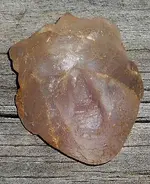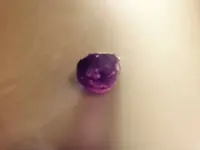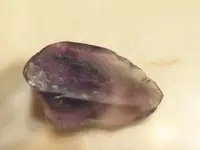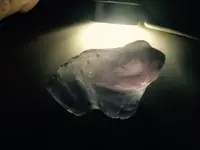Hardin County Illinois and Tolu, KY seem to be the hot spot, it was traded to the larger centers at Cahokia, Angel Mounds and Kincaid in Illinois. The occasional piece made it up the Ohio to the Ft. Ancient in Mississippian times, and the Hopewell moved it around a bit. You should take it to a show in the area, there's usually a couple of guys with a frame or two of the material and they could tell you a lot more about.
The green could be algae, but many of the purple fluorite crystals have a greenish tinge on one end. There are also yellow as well as pure green specimens. Some of the replicas I've seen, were made out of some large perfectly purple crystals that come from mines. (One guy was making discoidals out of them for years.)
You should put it under a UV black light, and watch what happens. If it's freshly made, it'll glow and probably hold a glow for a while after the light is removed. Older specimens that have been exposed to natural UV light over the years in a field will change color, but won't hold a glow. It's not a perfect authenticity test because some specimens of flourite won't glow, but I know some guys who use it. Fluorescent lighting was named after the mineral; apply the right kind of energy and you can get it to produce light.
The Aztecs down in Central Mexico used it a lot, and evidence shows that they heated it up which would cause it glow for quite some time. Some areas produce a variety known as Chlorophane that will glow at low temps (body heat, warm water, etc.) Other varieties, when freshly worked, if left out in the sun on a very bright day would glow slightly if taken in to a dark room (cave, tent, etc.) It would be subtle, but probably seemed magical to ancient people.
Not sure if the natives in your area knew about the properties, but my guess is it sometimes happened and they were impressed.
 Attached Thumbnails
Attached Thumbnails




 (for which I'm very grateful!) Would love to see the owl- if it's still possible. And more pics of your little croaker. Thanks so much for posting and bring up this very interesting topic. Yakker
(for which I'm very grateful!) Would love to see the owl- if it's still possible. And more pics of your little croaker. Thanks so much for posting and bring up this very interesting topic. Yakker




